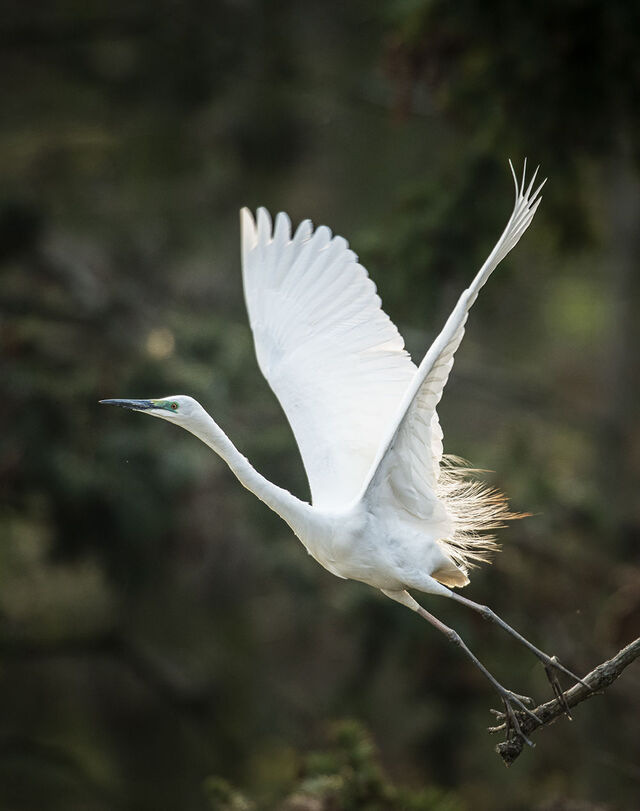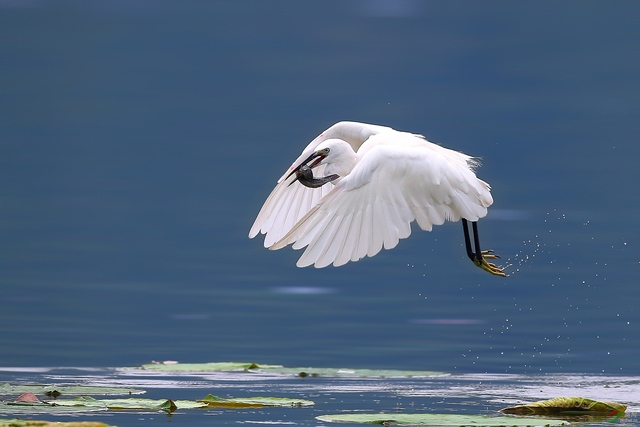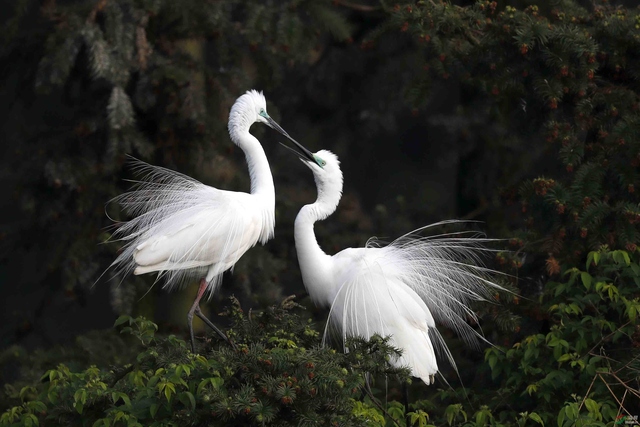Ardea alba
IUCN
LCBasic Information
Scientific classification
- name:Ardea alba
- Scientific Name:Ardea alba,egret, heron, white floating bird, winter village, great white crane, white crane heron, white village, snow guest
- Outline:Wading birds
- Family:A.alba
Vital signs
- length:820-981mm
- Weight:625-1100g
- lifetime:7-10years
Feature
The whole body is pure white. During the breeding period, there are three rows of long and straight feathers with scattered branches on the shoulders and back, extending all the way back to the tail end. The beak can change color with the seasons.
Distribution and Habitat
It inhabits lakes, swamps, ponds, estuaries, paddy fields and seashores. It is common to see it alone or in groups foraging in shallow water. It mainly feeds on fish, but also shrimps, frogs, tadpoles, lizards, crustaceans, etc., and occasionally small birds and small rodents.
Appearance
The whole body is pure white. During the breeding season, the feathers on the back are long and developed, like fine threads spreading to the tail. The skin between the eyes is blue-green, and the beak is black, with the beak crack exceeding the eyes. During the non-breeding season, the feathers on the back fade, the blue-green skin between the eyes disappears, and the beak turns yellow. The iris is yellow, the beak is black during the breeding season, yellow during the non-breeding season, and the feet are black.
Details

The great egret (scientific name: Ardea alba) is a bird of the genus Egret in the family Ardeidae, order Stork. It is also known as Baizhuang, Gongzi and Baiwa. The feathers of the whole body are white; the eyes are yellow; the beak is orange-yellow (black during the breeding season); the neck has an "S"-shaped knot, the beak is slit past the eyes, the skin on the face and around the eyes is green; the tarsus and feet are black. There are cape feathers on the back and shoulders, which are longer than the tail. The cape feathers disappear after the reproductive period.
Great egrets are widely distributed around the world. In China, it is found in Northeast China, Hebei, Jiangsu, Yunnan, Guangdong, Hainan, Taiwan and other places. Inhabits rivers, seashores, swamps or paddy fields. He is quite alert and will fly away when he sees people. They mostly forage for food alone during the day, and they also move in small groups in food-rich areas. Feeds on small fish, shrimp, aquatic insects, shellfish, etc. The breeding period is from April to July. They breed once a year and lay 3-6 eggs per clutch. The most common number is 4. The eggs are sky blue. The incubation period is about 25 days and is shared by both male and female parent birds.
The great egret is listed in Appendix III of the Convention on International Trade in Endangered Species of Wild Fauna and Flora (CITES); it is listed in the "Nationally Protected Beneficial or Important Economic and Scientific Research Value" issued by the State Forestry Administration of China on August 1, 2000. List of terrestrial wildlife.
The great egret is a large heron with a very long neck and legs, similar sexes, and a white body. During breeding, there are three rows of long and straight feathers with scattered barbules on the back of the shoulders, extending all the way back to the tail end, and some even exceed the tail end by 30-40 mm. The stems of the feathers are ivory white, with a strong base and gradually become smaller at the tips. The barbules are slender and scattered, and are sparse. The underparts are also white, and the feathers on the abdomen are slightly yellow. The mouth and eyes are black at first, and there is a black line from the corner of the mouth to the back of the eyes. The beak is slender and yellow. All or part of it will turn black during breeding. The mouth can change color throughout the year. During the spring and summer breeding season, its bill is pure black, but in autumn and winter, it turns completely yellow. Therefore, when you see the great egrets in the picture, you can easily identify whether they are in the breeding season; their calls are the croaking sounds they make in the breeding nests. The whole body is mostly white, and the winter feathers are similar to the summer feathers, but there are no longer feathers on the lower part of the front neck and the back of the shoulders, and the mouth and eyes are yellow first. The iris is yellow, the mouth, eyes and skin around the eyes are black during the breeding period and yellow during the non-breeding period. The exposed flesh of the tibia is green or red, and the tarsometatarsus and toes are black.
Size measurement: male weight 840-1100 grams, female 625-1025 grams; male body length 897-981 mm, female 820-855 mm; male bill peak 95-118 mm, female 96-104 mm; male wings 348-379 mm , female 330-350 mm; male tail 115-162 mm, female 122-138 mm; male tarsometatarsus 145-170 mm, female 135-140 mm.
Habits: Often seen alone or in small groups of more than 10 herons, sometimes large groups of more than 300 are seen during the breeding period, and occasionally mixed with other herons. It is active during the day, moves extremely cautiously, and flies away when it encounters people. When it first flies, its wings flap awkwardly and its feet hang downward. After reaching a certain height, it flies extremely flexibly. Its feet also extend backward, far beyond the tail. The head shrinks to the back and the neck protrudes downward. Sac-shaped, the wings beat slowly. When standing, the head is also retracted on the back and shoulders, forming a hunchback shape. When walking, he often shrinks his neck and advances slowly step by step.

Food habits: Feed on Orthoptera, Coleoptera, Diptera insects, crustaceans, molluscs, aquatic insects, as well as animal foods such as small fish, frogs, tadpoles and lizards. They always appear in scattered groups on mudflats or river banks, mainly wading in shallow water areas to look for food. They also often walk slowly on the grass near the water, pecking as they go. They have a high degree of patience and superb hunting skills. Once they find food, they use their sharp beaks to "suddenly attack" and capture the food quickly and accurately. .
The great egret is part summer migrant, part traveler and part winter migratory. They usually move to the northern breeding grounds from the end of March to mid-April, and begin to move away from the breeding grounds in early October to overwinter in the south. When migrating, they often form small groups or family groups, migrating in diagonal lines or at a certain angle.
The breeding period is from March to September. They nest in tall trees or in reeds, often in clusters. Sometimes there are several to dozens of pairs nesting in a tree at the same time. They also nest together with herons, and the male and female parent birds do this together. The nest is relatively simple, usually made of dead branches and dry grass, and sometimes there is a little soft grass inside the nest. The outer diameter of the nest is 56-61 cm, the inner diameter is 52-54 cm, the height is 22-25 cm, and the depth is 15-20 cm. They breed once a year and lay 3-6 eggs per clutch, mostly 4 eggs. The eggs are oval or oblong, sky blue, 51.5-60 mm × 34-41 mm in size, and weigh 29-31 grams. Incubation begins after the first egg is laid, and is shared by both male and female parent birds. The incubation period is 25-26 days, and the chicks are late adults. The fluff of the newly hatched chicks is light yellow, sticking to the whole body, and the eyes are half open. The mouth is orange and the weight ranges from about 40g to 66g. One day later, all the fluff on the body is dry and white, and the eyes open. At this time, the parent bird begins to feed them food. After the chicks hatch, the male and female parent birds jointly feed them. During the month after the chicks are born, the parent birds will take turns taking care of the chicks in the nest until the chicks can leave the nest and fly.

Distributed in Afghanistan, Albania, Algeria, Angola, Anguilla, Antigua and Barbuda, Argentina, Armenia, Aruba, Australia, Austria, Azerbaijan, Bahamas, Bahrain, Bangladesh, Barbados, Belarus, Belgium, Arabia Leeds, Benin, Bhutan, Bolivia, Bonaire, Sint Eustatius and Saba, Bosnia and Herzegovina, Botswana, Brazil, Brunei, Bulgaria, Burkina Faso, Burundi, Cambodia, Cameroon, Canada , Cayman Islands, Central African Republic, Chad, Chile, China, Christmas Island, Colombia, Comoros, Congo, Costa Rica, Côte d'Ivoire, Croatia, Cuba, Curacao, Cyprus, Czech Republic, Denmark, Dominica, Ecuador, Egypt, El Salvador, Eritrea, Ethiopia, Falkland Islands (Malvinas), France, French Guiana, Gabon, Gambia, Georgia, Germany, Ghana, Greece, Grenada, Guadeloupe, Guam, Guatemala, People of Guinea, Guinea-Bissau, Guyana, Haiti, Honduras, Hungary, India, Indonesia, Islamic Republic of Iran, Iraq, Israel, Italy, Jamaica, Japan, Jordan, Kazakhstan, Kenya, South Korea, North Korea, Kuwait, Kyrgyzstan, Laos Democratic Republic of the Congo, Latvia, Lebanon, Lesotho, Liberia, Libya, Macau, Macedonia, Madagascar, Malawi, Malaysia, Maldives, Mali, Mauritania, Mauritania, Mayotte, Mexico, Federated States of Micronesia, Moldova, Mongolia, Montenegro, Montserrat, Morocco, Mozambique, Myanmar, Namibia, Nepal, Netherlands, Netherlands Antilles, New Zealand, Nicaragua, Niger, Nigeria, Northern Mariana Islands, Oman, Pakistan, Palau, Palestine, Panama, Papua New Guinea, Paraguay, Peru, Philippines, Poland, Portugal, Puerto Rico, Qatar, Romania, Russian Federation, Rwanda, Saint Kitts and Nevis, Saint Lucia, Saint Martin (French-speaking), Saint Vincent and the Grenadines Dinnes, Saudi Arabia, Senegal, Serbia, Sierra Leone, Singapore, Sint Maarten (Dutch), Slovakia, Slovenia, Solomon Islands, Somalia, South Africa, South Georgia and the South Sandwich Islands, South Sudan, Spain, Sri Lanka, Sudan , Suriname, Swaziland, Switzerland, Syrian Arab Republic, Tajikistan, United Republic of Tanzania, Thailand, Timor-Leste, Togo, Trinidad and Tobago, Tunisia, Turkey, Turkmenistan, Turks and Caicos Islands, Uganda, Ukraine, United Arab Emirates, Uruguay, Uzbekistan, Venezuela, Vietnam, Virgin Islands, Yemen, Zambia, Zimbabwe.
Travelers: British Indian Ocean Territory, Djibouti, Equatorial Guinea, Fiji, Finland, Ireland, Liechtenstein, Luxembourg, Malta, New Caledonia, Norway, Saint Helena, Ascension Island and Tristan da Cunha Island, Saint Pierre and Miquelon, Sao Tome and Principe, Seychelles, Spain, Sweden, United Kingdom.
Distributed in China: Hulunchi, the Heilongjiang River Basin in northeastern China, and western and central Xinjiang. During migration and overwintering, it is found in the northwest, west, and southwest of Gansu, Shaanxi, Qinghai, and Tibet. It is occasionally seen in Liaoning, Hebei, Sichuan, and Hubei in the northeast; Common Asia The species breeds in Jilin, Liaoning, Hebei, Fujian, and Mengzi in southeastern Yunnan in northeastern China; during migration and wintering, it is found in Henan, Shandong, Jiangxi in the middle and lower reaches of the Yangtze River, and the southeastern coast of Guangdong, Fujian, Hainan Island, and Taiwan.
The image of the Great Egret is depicted on the back of the Brazilian 5 reais banknote, and also appears on the New Zealand $2 coin.








